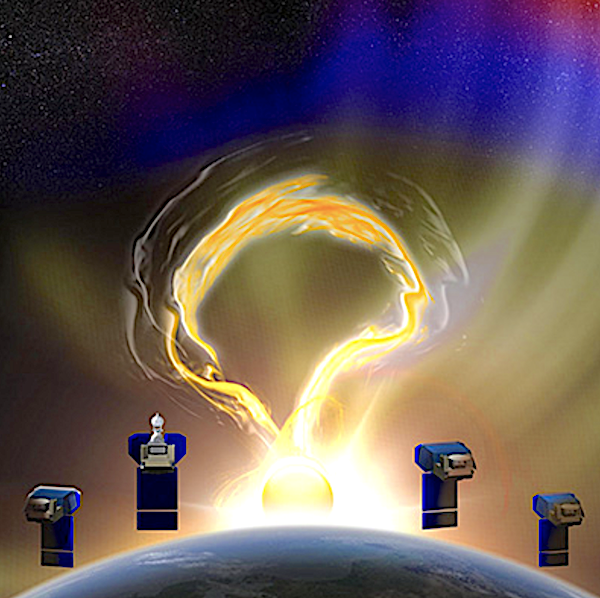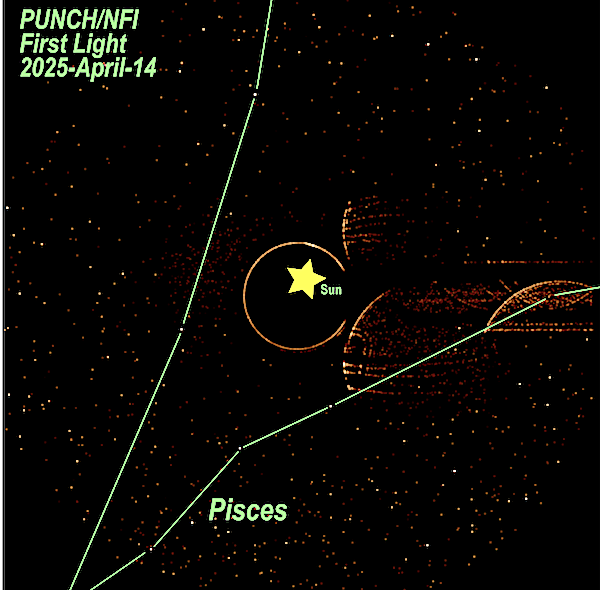
NASA’s PUNCH (Polarimeter to Unify the Corona and Heliosphere) mission successfully completed spacecraft commissioning this week, opening its instrument doors to capture “first light,” the mission’s first images of the Sun’s outer atmosphere and the surrounding space. This is the first step in revealing new details of how the solar atmosphere unfolds and streams through the solar system. Now, mission operation teams will continue the commissioning phase for the spacecraft’s instruments.

Credits: NASA/SwRI/NRL
On April 14, the Narrow Field Imager (NFI) and one of the mission’s three Wide Field Imagers (WFI) opened its instrument doors and captured the first images for the mission. On April 16, the remaining WFIs opened their doors and also started capturing images. The first NFI image shows star fields with the Sun near the center of the image. The image was filtered to emphasize background star fields, which was obscured by zodiacal light, a very faint diffuse glow from dust orbiting the Sun.
Throughout the commissioning phase, scientists will be calibrating this view to better reveal details the Sun’s corona, or wispy outer atmosphere. This calibration process will remove about 99% of the light from the corona, enabling scientists to track the faint threads of solar material as they flow outward throughout space.
The WFI image below, taken April 14, shows the wide field of view from WFI and is marked with labeled constellations. As commissioning progresses, the PUNCH team will be removing the star fields and other background light from all images to highlight the faint stream of solar wind as it travels toward Earth.

Credits: NASA/SwRI
These early images confirm a crucial milestone: the cameras onboard PUNCH’s four satellites are in focus and functioning as designed.
The PUNCH mission will make global, 3D observations of the inner solar system and the Sun’s outer atmosphere, the corona, to learn how its mass and energy become the solar wind, a stream of charged particles blowing outward from the Sun in all directions. The mission will explore the formation and evolution of space weather events such as coronal mass ejections, which can create storms of energetic particle radiation that can endanger spacecraft and astronauts.
During this first phase of the commissioning period, the team at mission control at Southwest Research Institute in Boulder, Colorado, worked to assure that the four satellites were functioning correctly and are moving into the proper orbit around Earth and distance from each other to create the PUNCH constellation.
The PUNCH satellites include one NFI and three WFIs. The NFI is a coronagraph, which blocks out the bright light from the Sun to better see details in the Sun’s corona. The WFIs are heliospheric imagers that view the very faint, outermost portion of the solar corona and the solar wind itself. Once the PUNCH satellites reach their targeted alignment, the images from these instruments will be stitched together to create the wide view of the journey of the Sun’s corona and solar wind to Earth.
Once the commissioning is complete, PUNCH will provide the first-ever imagery of the solar wind and coronal mass ejections in polarized light, enabling scientists to discern new information about this activity.
Southwest Research Institute, based in San Antonio, Texas, leads the PUNCH mission and operates the four spacecraft from its facilities in Boulder, Colorado. The mission is managed by the Explorers Program Office at NASA Goddard Space Flight Center in Greenbelt, Maryland, for the Science Mission Directorate at NASA Headquarters in Washington.
Author: Abbey Interrante, NASA Headquarters, Washington
